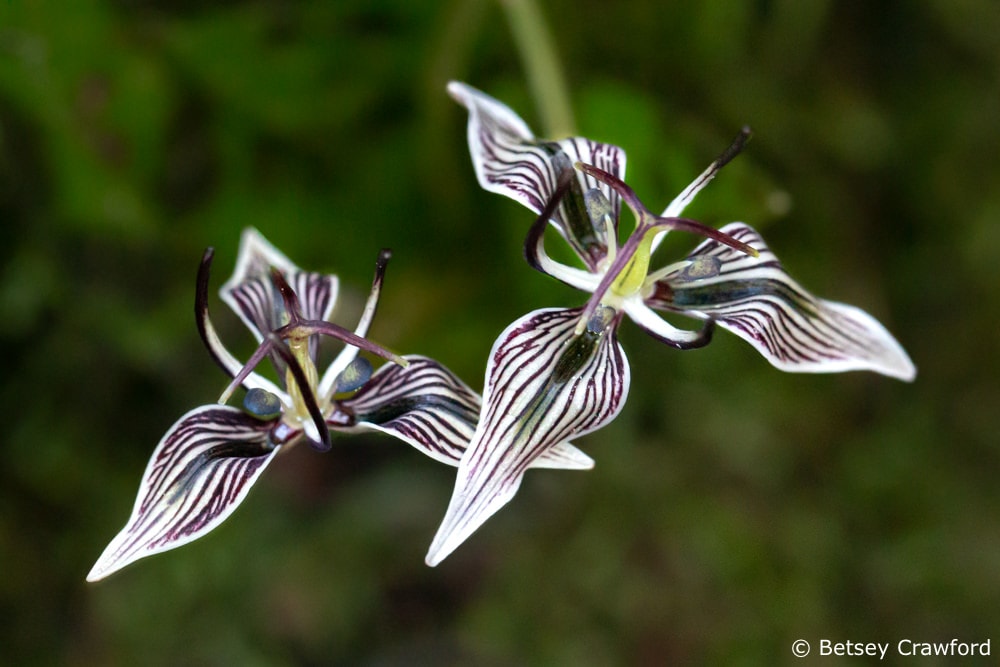
The act of looking, of paying attention, is akin to prayer for me. It can be transporting….Plants are my doorways to wonder.
~Robin Wall Kimmerer~
The first year I saw nothing but handsome corrugated leaves with irregular brown markings. They reminded me of the trout lilies in my native northeast forests, so I looked forward to the flowers. But they never came. The leaves looked like the type that would accompany flowers. But forests have lots of plants that leaf but don’t bloom, so I wondered if that was the case. Or was it an off-year for that plant? Were they biennials, which bloom every other year? Or had I missed them?
I was new in California. A friendly woman in a yoga class welcomed me and told me about nearby trails, including a two-mile loop at the top of King Mountain. It wasn’t a regular hike for me, so I could easily have missed the flowers. I determined that I’d go earlier the next year, which I did.
That year I saw stems, the bloom having finished. The stems curved over the edges of the leaves. positioning a seed pod to drop its seeds handily on the forest floor. So now I knew I had a flowering plant. I would stalk them the next year, starting in January, to see if I could see the flowers.
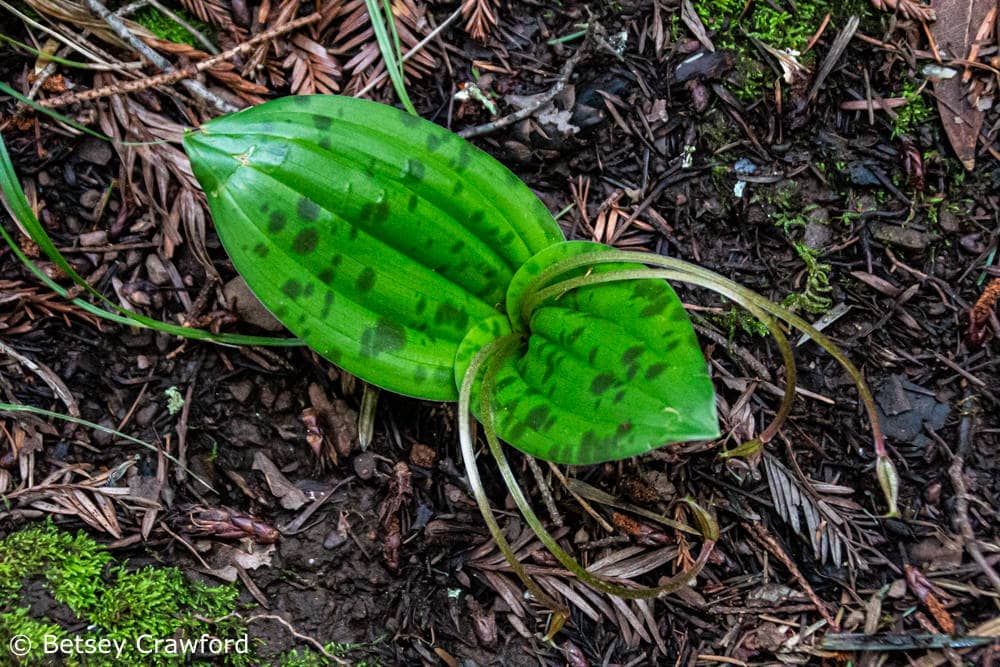
They are not easy to find. I took the picture below in a well-lit spot about 18 inches above a couple of plants with eight blooms between them. They are small and their dark purple and cream striping produces a speckling that blends easily with the surrounding variegated scene. As do the mottled leaves.
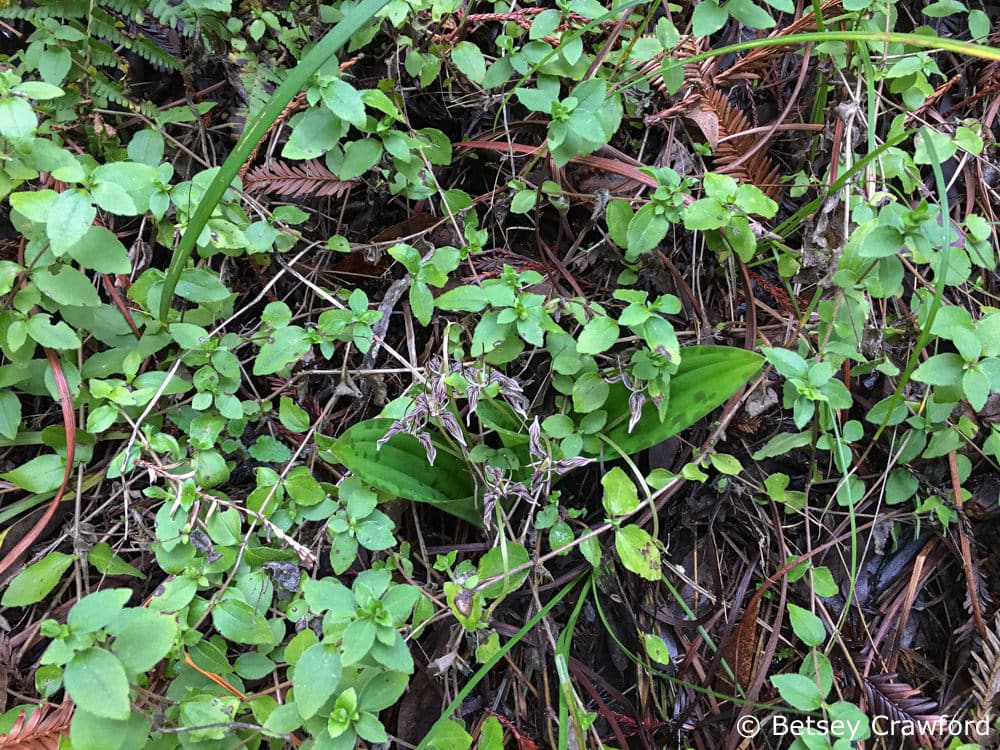
But one day, to my utter delight, I finally saw my first flowering Scoliopus bigelovii. Scoliopus is derived from the Greek for curved foot. Bigelovii is after nineteenth-century American botanist John Milton Bigelow. Credited, as is too often the case, with discovering a plant that Indigenous people have known for at least 10,000 years.
But let’s ignore that uninspiring term for now because nothing can beat its common name: fetid adder’s tongue. Part of its charm is that it doesn’t make much sense. Unlike a name like buttercup, which describes a yellow, cup-shaped flower.
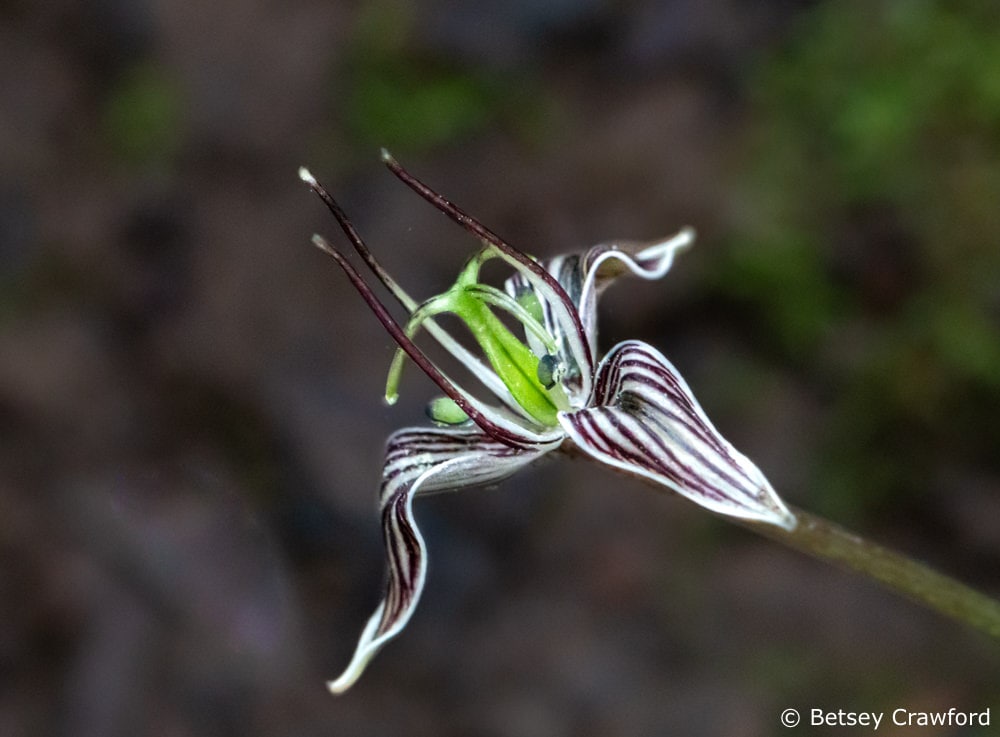
Adder’s tongues have a particular affinity for redwood forests, which are indigenous to California. But the state, home to ten different types of rattlesnakes and even a few boas, doesn’t host adders. All snakes’ tongues are forked, but there are no obvious forks here. The reference is to the divided tip of a stolon, or runner, that travels underground, connecting plants and starting new ones.
So fetid is the only part of the name with some immediately apparent facts behind it. The word implies that the plants have an unpleasant smell. It doesn’t permeate the surrounding air. Since they’re only a few inches off the ground, I had to sniff a few to find a distinctive odor. Most smelled like the rich forest floor of humus and slowly composting redwood and fern stems they grow from.
I eventually found something different. Not terrible, but certainly not something you’d choose. It reminded me of having a wet dog in the back of the car. A smell that must appeal to the fungus gnats that pollinate adder’s tongues in the chilly months before bees are active.

One year, I moved onto the side of King Mountain. To get to my apartment, you drive up a steep hill for a quarter of a mile. To get to the loop from there, you hike up a steep fire road for another quarter of a mile. So now it’s my backyard hike. Wildflowers are abundant: delicate milkmaids, vivid blue houndstongue, bold white death camas.
The whole loop is forest. About a third is redwood forest, and the adder’s tongues start and stop at the boundaries of that section. Because those curving stems drop their seeds next to the plant they’re from, they grow in colonies. Helpful ants thrive on the nutritious elaiosomes of the seeds. By carrying them away to their nests, they create new clusters.
In some seasons, the adder’s tongues go mad. No need to keep stalking. It’s hard to imagine the years when I could barely find them. They seem to be looking for me at this point.

Which is not much of a stretch now that we know plants have ocular cells in their leaves. As I bring my eyes close to them, are they looking back? We know they can sense and respond to their surroundings. That they communicate with the rest of the forest. Am I, bending over them with my camera, considered an attacker? Do they send chemical signals to other plants that I’m a danger?
Or do they read my love for them? Plants can learn and remember. They create relationships. When I come to visit, day after day, do they get used to me? Do they learn the chemical signals I give off? Are they always slightly wary, or do they welcome me after a while?
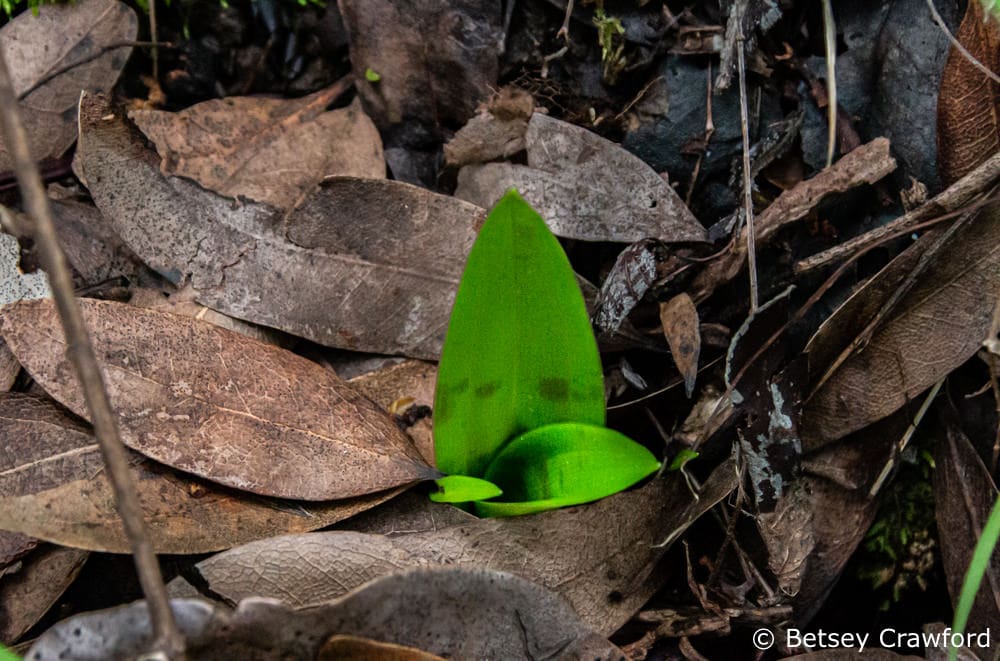
I give them the greatest gifts I have to offer — love and the desire to pay deep attention. I watch their green shoots push out of the dried leaves and redwood twigs on the forest floor. Watch them curve open, watch the pointed oval buds slowly rise on delicate stems and the striped sepals open. I see their spiky petals rising above the anthers and stamens, lending a somewhat gothic air.
I’ve never seen the fungus gnats, but when bright yellow pollen spills on the sepals, I know they’ve been there. Then I watch the sepals slowly fade as the weight of the swelling ovaries bring the stems curving to the ground.

Then, though wistful at the flowers’ fading, I watch for the ripening of the fruits as they open and release their seeds. The leaves get longer and more pointed as they age, and eventually disappear.
In this quiet cycle in the heart of the forest, they are giving me the greatest gifts they have. Life, beauty, mystery, a glimpse of the deepest creative forces of the cosmos, wonder, awe. Though these particular blessings are fleeting, the earth offers us such profound nourishment all the time.
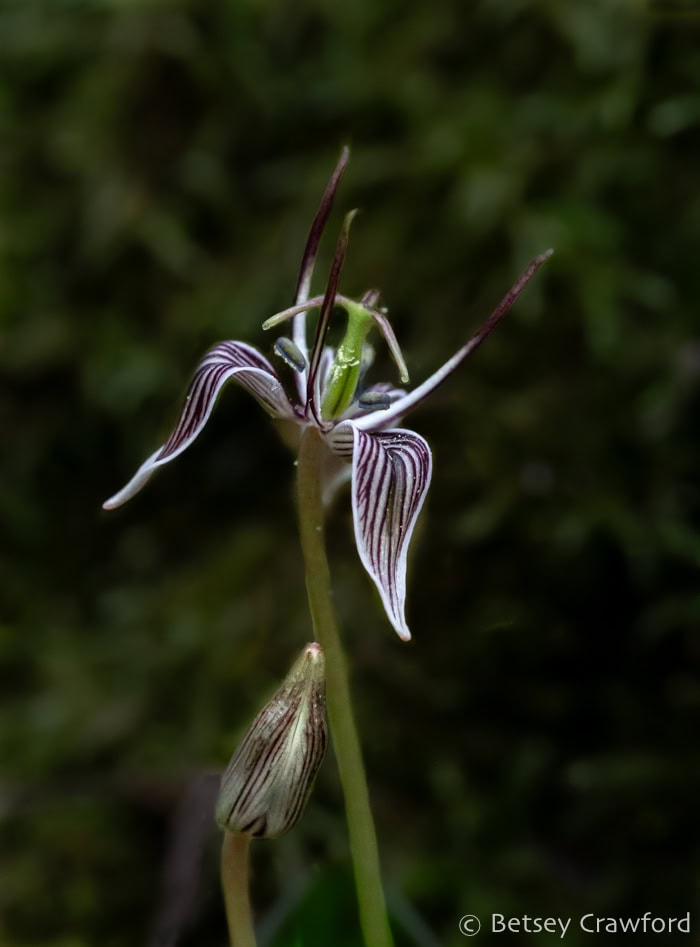
~ RELATED POSTS ~

FERNS: THE DEEP CONSOLATIONS OF SURVIVAL
Ferns are a hardy bunch. We would be, too, if we had survived for 360 million years, outlasting two major extinctions, feeding dinosaurs along the way. Their ancient lineage gives our own existence depth to depend on. Plus — a big surprise.

A ROSE BY ANY OTHER NAME IS COMPLICATED
Thanks to Linnaeus, I can communicate with a botanist anywhere and know we are speaking of the same plant by using the scientific name. Very handy. Since this spread was largely fostered by colonialism, it’s also very complicated, right down to today.
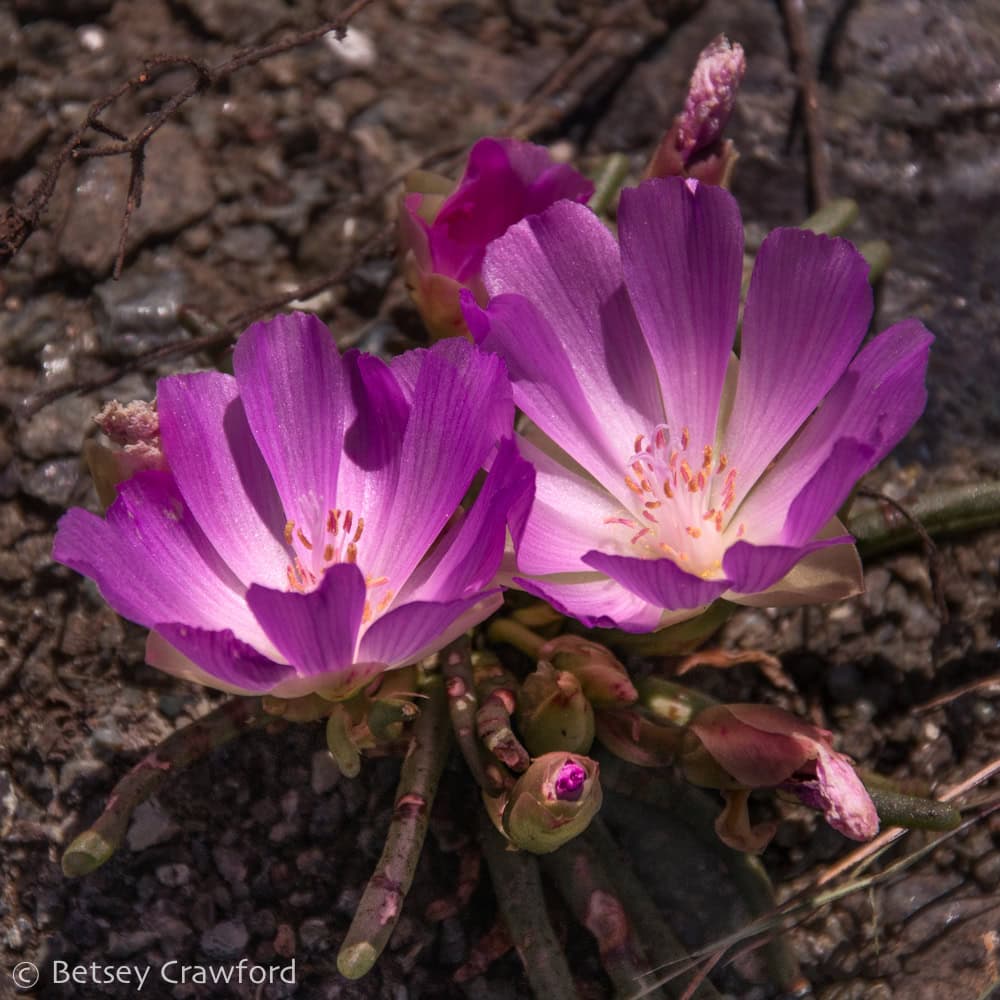
LIVING ON THE LEDGE: INGENIOUS BITTERROOT
This is a story about a difficult and fascinating terrain, a beautiful, adaptable flower, and a maddening claim. There are thousands of such stories in the intertwined history of humans and plants.
So lovely to read that others too visit the fairy flowers of spring that run giggling through the forest this time of year! The description of smelling first soil then a wet dog was exactly the experience i remember too! Thank you for sharing your wonderful words and pictures! I plan to discuss this plant on a radio show this week. I will mention this lovely website as well! Maybe I’ll see you all in the woods soon 😉
Thank you, Pamela! It’s such great plant. I hope your talk inspired others to go out into the woods. And to take their kids!
Hi Betsey,
Thank you for such a beautiful story of one of my most favorite wildflowers. I too had seen the leaves, wondered, read about the lily with the amazing name (and later learned three others, including Brownies), but I kept searching too late. Now I know of several places to see them so visit them every year. I eventually found a spot where I’ve seen the last ones blooming on April first. I also found some places where friends with limited mobility can see them. (Also, they were said to be in the East Bay, but I’ve never found any.)
I also hope they feel our love and caring for them. I talk to them. I finally realized this year that I think the “adder’s tongue” is about their seed pods/fruit having tips that look like a tiny snake’s forked tongue, like in your last beautiful photo. I think “slink pod” is about their fruit/seed pods slinking down from the plant on their little stem.
I’ve thought their scent was like low tide, which I love, but maybe I’m missing something.
Thank you so much for your appreciation and insights. I now have to go and inspect the seed pods’ tips. I can go with low tide. Not a bad smell, but not something you’d want wafting through the house.
When I first lived in California at 15, moved here by my parents, we ended up in Foster City, at that time with few houses but the smell of the Bay and mudflats everywhere, which I loved. So the Fetids are lovely for me.
I think “Slink Pod” refers to the slinky tendrils holding the fruit with coming seeds.
Your posts are incredible!!!
It did that loop at King Mountain for the first time this spring, searching for the Fetids, and found them.
It would be nice to meet up with you on a wildflower/nature stroll some time.
Thank you, Bev! I love the idea that the fetids remind you of the mudflats of your late childhood. King Mountain is great. We are so blessed to have so many wonderful hikes in the area. I hope we do meet up!
Thanks, Betsey, I love making a pilgrimage to my favorite wildflowers. You made the experience come alive! Your exquisite writing opens the hidden mysteries of flowers!
Gratefully,
Lin Neil
Thank you so much, Lin. What a lovely comment!
Hi Betsy,
As a former Ranger at S. T. State park where I lived and worked 7 yrs. (1964-1971) I too would always look for the Adders Tongue along with the entire spread of of seasonal flowers. Another name used for Adders Tongue is Slink Pod. I especially loved your previous post, as winters were always a favorite. Working and resting against a tree with my coffee thermos and listening to the silence is one of my fondest memories. Thank you for your wonderful prose. I never fail to read it.
Don Engler
Thank you so much for this lovely note, Don. What wonderful memories. I came across slink pod, but I can’t remember where it got the name.
Hi Betsey,
Wonderful!
This reminds me of how delighted I was to finally stumble upon morels. A gift in May…Just for paying attention.
Thank you! Yes, the first time we find something is so special. And then fascinating how we see so much more of it after that.
Betsey, your exquisite witnessing — bending down, seeking, watching, admiring and tending leaves me full of admiration. I feel as though I have been stalking this precious plant with you, that in some strange way, it is now in my energetic vocabulary of early spring woodland plants. And the sense of the plant watching you is palpable. If we all entered the spring landscape with this degree of humility and awe, what would change? Almost everything, I believe! Thank you, Andrea
Thank you for this beautiful note, Andrea. Means the world to me.